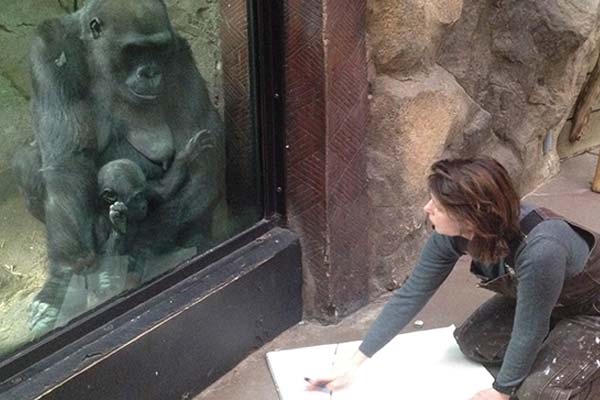Interview with Jen Bradley
By Jennifer Nelson, WTP Feature Writer
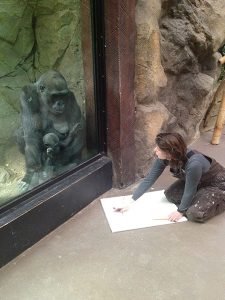
Jen Bradley is a painter and printmaker whose work has been exhibited in the United States, and is held in public and private collections in America and abroad. In 1994, Bradley began routinely drawing at the gorilla habitat at the Franklin Park Zoo in Boston. Since then, she has continued to record her experiences and observations through the process of drawing and video. She refers to this ongoing series as The Ape Drawing Project. Her recent work contains references to mythical geographies, interiors, and the natural world. She received a BFA from Massachusetts College of Art, MA. She splits her time between Boston and Provincetown, MA.
See her work in WTP Vol. VII #6.
Nelson: How did growing up in Boston, the daughter of a scientist and nurse, impact your decision to pursue art as a career, and what are your early memories of creating art?
Bradley: My father, who was a biology teacher, taught me about animals and plants in a very passionate way, which teachers know how to do. Growing up, animals and plants were worshipped. We would collect pond water in jars, then carefully set up slides, and put them under the microscope. My father would ask me to draw everything I saw on drawing paper next to the microscope. I learned about microorganisms. I enjoyed the process, looking to discover shapes and details as a challenge and similar to a game.
I was very lucky to go to a small Montessori school, where I was encouraged to draw. I see how the groundwork was laid for why I make art using a lot of processes and across disciplines.
During the 1980s, my mother was a hospice nurse and took care of people with AIDS. She was also very passionate about her work. I overheard intense conversations between my parents about the crisis and confusion about an illness, as well as many lessons on virus and genetics. In our house, the biology books would come out and we would have discussions anytime there was an illness. I was very lucky to have the example of both parents who loved their work. Both teaching and nursing require certain qualities that I was taught to admire.
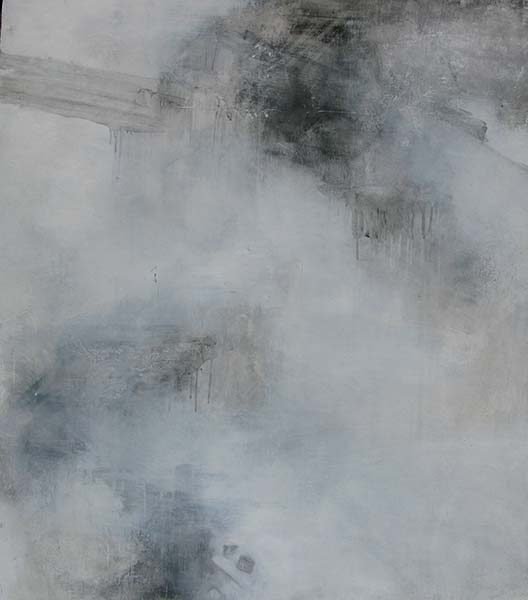
Nelson: As an artist-in-residence at the Franklin Park Zoo, you have observed and been drawing gorillas for twenty-five years. What fascinates you about these animals, and how and why have you shifted your artistic gaze to pay attention to people at the zoo?
Bradley: I am drawn to gorillas because they are human-like, but their bodies are more abstracted than ours. I love the way they move. Drawing has become an intuitive way to process information and concentrate for me. The zoo experience is the intersection of sociology, psychology, and anthropology.
I love to draw from observation. I have come to know the zoo community and I have become a part of it. In spite of the debate about zoos and animals in captivity, zookeepers are incredible, amazing people. They are well educated and hardworking—and dedicated to animals in a passionate way that reminds me of how artists can be. They have dedication and drive without regard for financial gain.
People often have a powerful, almost spiritual connection to animals and nature. Relationships with animals are perhaps our most significant relationships because we often use all our senses to communicate with them. We must be present. To reach out to them, we don’t use our phones or other technologies. We pay attention to them in the moment—and they are like that with us. They are true.
In my paintings, I put my experiences of feeling from the gorillas and humans at the zoo, though I’m not fully conscious of doing it. I observe and feel it and it goes into the painting. When I get back into my studio, I make marks and use brushes.
After twenty-five years, I feel connected to individual gorillas. Recently, Joe, who is twenty-seven years old, charged the glass when I hugged a male zookeeper. Does he consider me one of his females? I get a kick out of that idea being true. But I have been taught by the zoo to refrain from anthropomorphizing.
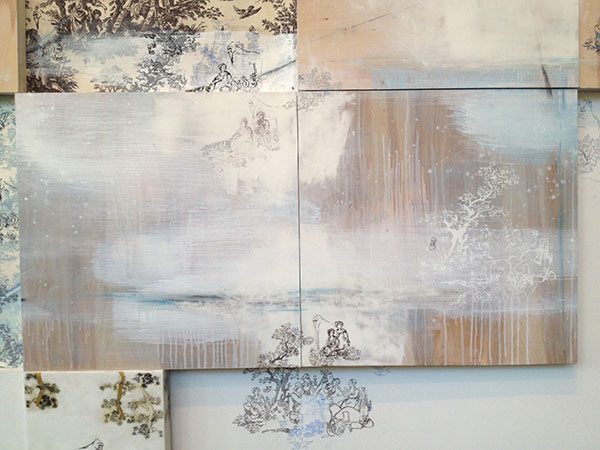
Nelson: How did spending summers as a teenager in Alsace, France, influence your artwork, particularly perhaps the series Les Fleurs du Mal, abstract mixed-media paintings? And can you talk about this, how you move back and forth between the more abstract and the more linear of your ape drawings? How does one influence the other?
Bradley: When I was thirteen, fourteen, and fifteen years old, I was lucky to be with a childhood friend and her French family. I loved the language and the culture as it contrasted with the culture at home. It was a very formative experience to be in the mountains and lead a simple life—even though for me, growing up in the 1970s was pretty simple in many ways.
Some weeks in France we acted like we were bored, but it was really special because we read comic books and played in the grandmother’s garden. We went to museums. After each summer, I wanted to learn the language in order to fit in. So, in high school, I began intensely studying French. I learned about the existential poets.
My approach to abstract paintings and gorilla paintings is the same. I always start by drawing from observation. If I am making a painting about an interior or exterior space, I draw in order to study light and shapes of a room. By drawing, I gather information. I often make small ink paintings of the space in preparation to paint.
The gorilla paintings emerge from drawings. I can move back and forth between gorilla drawings, paintings, and abstract paintings. A gorilla can appear or be removed at any time in a painting. Sometimes I hide gorillas in paintings. A gorilla painting can become an abstract painting in ten seconds. I do not over think this. I am always focused on the painting’s balance and composition.
All the paintings are personal in some way and, of course, some paintings are more personal than others. It’s just the way it is.
I like larger scale paintings that relate to my body size, or paintings that can fit in my hand. I love to use and play with various types of methods used in oil painting. To paint, I use all kinds of brushes and rags. I layer, manipulate, and experiment with paint using processes such as encaustic and various types of glazes. I have given myself freedom to work in long series that may appear to be different bodies of work, but are all connected.
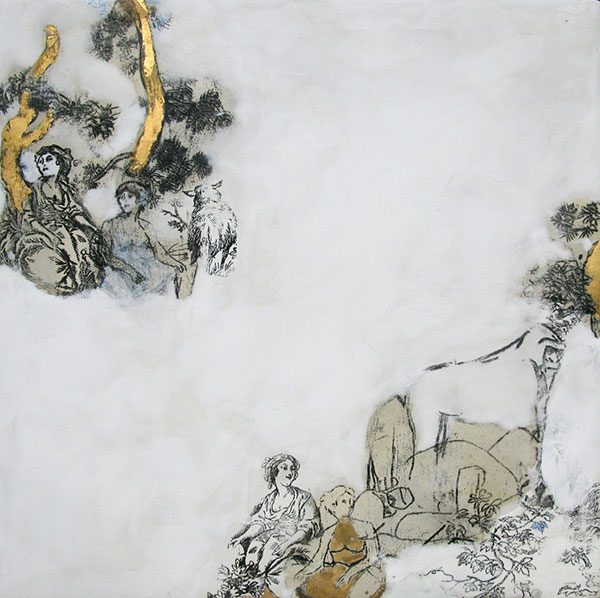
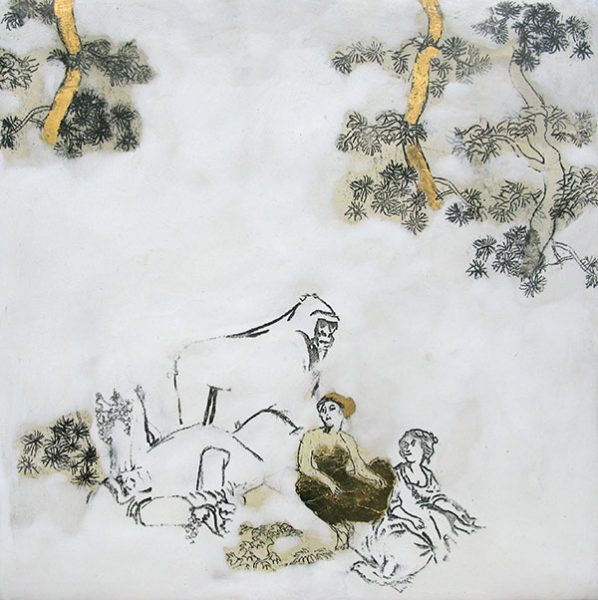
Nelson: Toile de Jouy is an interesting departure from your other works. Can you talk about this series as well as the medium—what is the mixed media?
Bradley: I had bought a roll of toile wallpaper simply because I liked it. I did not know what I would do with it. In the studio, I happened across this wallpaper, and I said to myself “Oh, I love the imagery, the repetition of pattern. There are the humans at the zoo!” I was paying more and more attention to people at the zoo. I thought about different ways to represent them: Would I draw them? No, I draw gorillas because I don’t want to draw people. I was unclear what I wanted to say about humans. I found a way to represent humans, the civilized people in the country having a picnic. The Toile series is also about class, an important theme for me. It added a narrative element, which was not in my work before.
The Toile series is on-going. In the first series, gorillas appear in the original scene, while in another, creatures are naked and having sex. In the Tous Ensemble Toile, a deconstructed and reconstructed series, my characters have evolved. I find this work playful and it makes me laugh, which I need to do.
I use a wood panel. I put plaster layers with sand between each layer. I transfer drawings on to plaster. I hand draw the images first, then photocopy them and finally do a crude type of lithograph transfer or I make screens for screen print. I love the print making process.
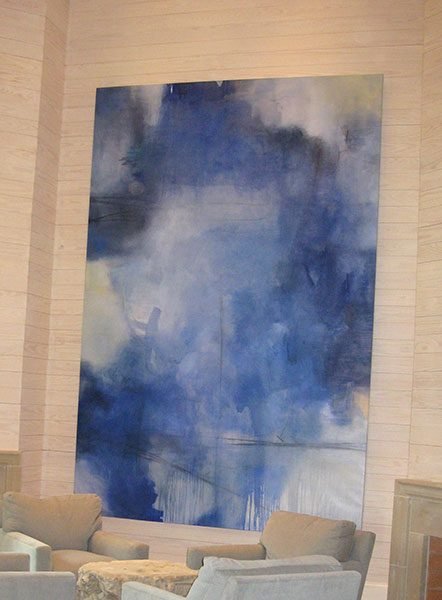
Nelson: How does your approach to commissioned artwork such as “Toile de Ciel” and “My Cerule” differ from your personal artwork?
Bradley: A commission is never the same in my experience as persona artwork. Both these paintings were site-specific installations with time restraints and were done while working a day job. That translates as a challenge to me and I like that.
“Toile de Ciel” has gorillas hidden in the toile. “My Cerule” reminds me of the ink paintings that I love to make. It is essentially a giant, 12-foot by 10-foot blue ink painting—it is all one color, just like when I use ink and I thin the paint very carefully using glazes and the white of canvas like it is paper. A designer saw my paintings and asked me if I would paint a site specific piece for a show house. I agreed. I took a chance that it would be bought. I still have this painting because it did not sell, so I guess it was not a true commission.
Nelson: Can you comment on your use of imagery from manufactured spaces from video games, as well as other sources of inspiration?
Bradley: I looked at video games for one show of paintings so this is not a habitual practice for me. A friend was playing video games and I enjoyed making ink paintings and small charcoal drawings of the light and feel of the animated spaces. At that time, I was also being more playful with incorporating elements of my toile objects in paintings. My sources of inspiration are nature, light and human-animal behavior.
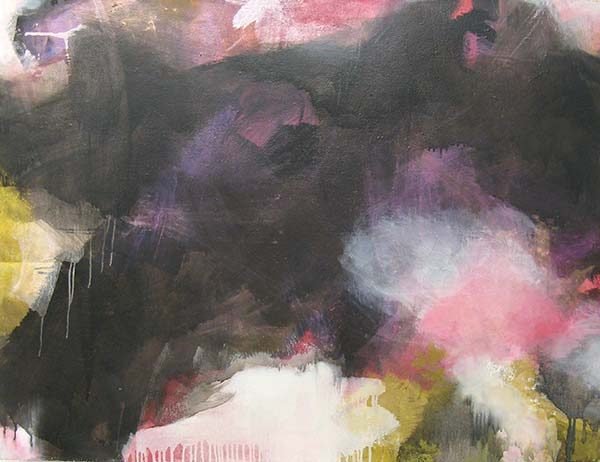
Nelson: How do you see your art evolving in the future?
Bradley: I see myself continuing to work in long series and my current themes will continue to evolve. I will continue to do my Ape Drawing Project. A lot of very serious paintings are going to be made. I feel like I have been in training for a very long time to make the paintings I am about to make. Most of my life I have not been able to be a full-time artist, until now. I have made sacrifices in order to work full time on my art. It is an exciting time for my work.
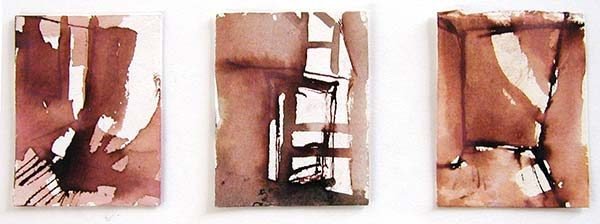
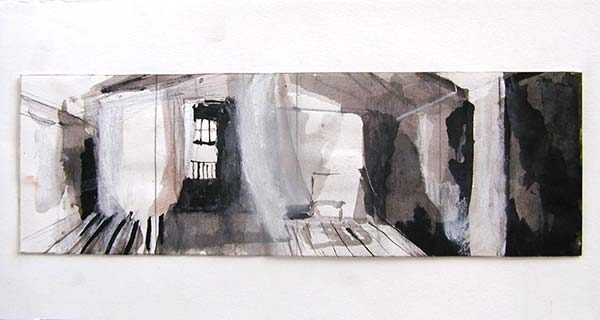
Copyright 2019 Woven Tale Press LLC. All Rights Reserved.

